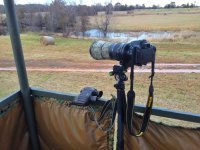pittpa
Member
Shot this guy with my longest lens, a 150-600 zoomed out.
With the Nikon Small Sensor, DX cameras you get a 1.5 multiplier effect.
So it's a 900 mm shot.
I learned that after I bought a used Nikon D 70 with a 35 to 80 zoom and a 28 to 200 zoom. It wouldn't go as wide as my iPhone 13 until I bought a 19 to 35 Nikon zoom which was a reasonable price and really works well. It's just a 6 mp camera.
What was cool was that even 15 years after that camera's release in 2004, Sony made good on the battery recall when I turned it into their website.
This little 2 mp Casio fit in an altoids tin and takes great pics. When I first had it, I took it to a Jimmy Buffett concert and it fell out of my shirt pocket and into my margarita.
It was used to take as many as half these eight by tens from antelope Canyon Arizona.






